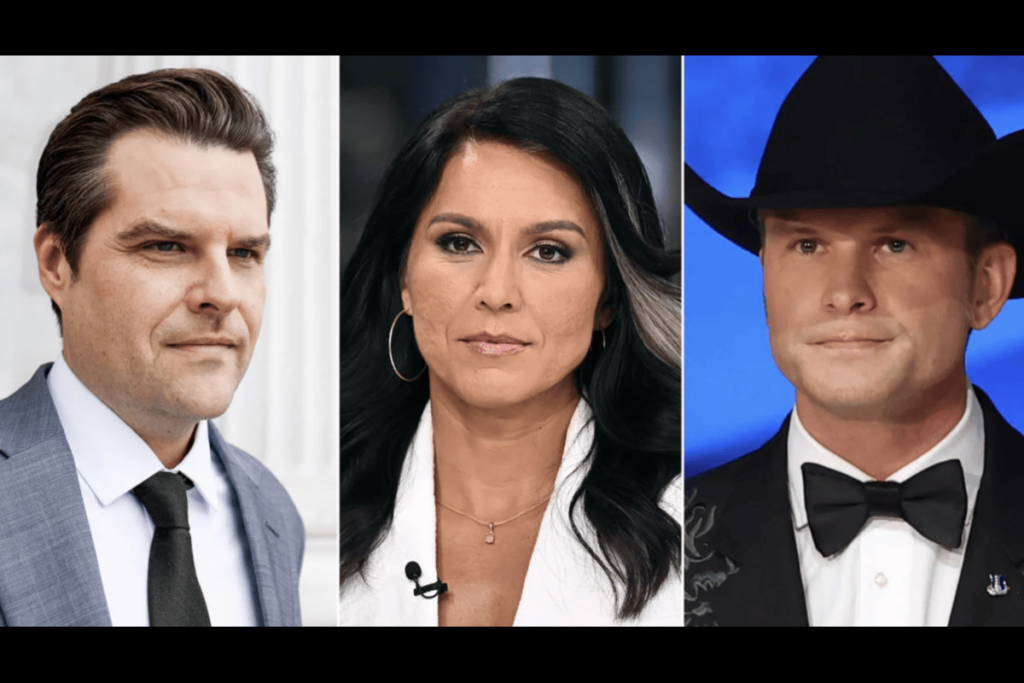Donald Trump’s recent Cabinet picks have caused a stir in Washington, particularly among Republicans.
However, this outrage isn’t accidental—it’s the point of his selections. Trump’s nominations are deliberately provocative, meant to trigger the establishment and energize his political base.
On Wednesday, Donald Trump escalated the controversy by announcing Florida Republican Matt Gaetz as his pick for Attorney General. Gaetz, a fervent Trump ally and a figure associated with previous investigations into his conduct, is a highly controversial choice. Similarly, former Democratic presidential candidate Tulsi Gabbard, who now aligns with Trump on issues like distrust of the intelligence community, was named his pick for Director of National Intelligence (DNI). These selections caused such uproar that they overshadowed the announcement of Fox News anchor Pete Hegseth as Secretary of Defense.
Trump’s picks for these positions are consistent with his broader political agenda: dismantling the government bureaucracy and rooting out what he perceives as corrupt elements. The uproar from Washington elites contrasts sharply with the enthusiasm from Trump supporters, who see his outsider status and confrontational approach as refreshing. His Cabinet nominees, if confirmed, will serve as key figures in his quest to reshape the government.
Trump won the presidency on a platform of change, and his controversial selections are a clear signal that he intends to fulfill that mandate.
These picks align with his long-standing mission to challenge the political establishment and pursue a more aggressive, populist agenda. His supporters believe that many of his legal troubles, including the Russia investigation, are the result of political persecution, and they back him in his efforts to “drain the swamp.”
Former Trump communications director Anthony Scaramucci described the personnel picks as a deliberate attempt to “own the liberals.” The goal, he explained, is to provoke strong reactions and keep Trump’s critics on edge. Pennsylvania Senator John Fetterman echoed this sentiment, calling Gaetz’s selection an example of “god-tier trolling” aimed at triggering a meltdown among Trump’s opponents.
Gaetz’s selection for Attorney General raises significant questions about Trump’s commitment to justice and the rule of law. Gaetz, who has faced ethical scrutiny and undergone an investigation by the House Ethics Committee, is far from the typical candidate for such a high office. However, his nomination aligns with Trump’s narrative of attacking the Justice Department, which he views as biased against him. By picking Gaetz, Trump signals his desire for an Attorney General who will defend him and confront his political adversaries.
Trump’s choice of Pete Hegseth as Secretary of Defense is also a provocative one.
Although Hegseth has military experience, his background lacks the high-level strategic expertise typically expected of the Pentagon chief. He is more widely known for his strong political views, particularly on issues like military diversity programs and his support for Trump’s controversial policies. This nomination seems to reflect Trump’s tendency to appoint loyalists who align with his culture war priorities, rather than individuals with extensive diplomatic or military experience.
Tulsi Gabbard’s selection for DNI is similarly contentious. Known for her skepticism of the intelligence community, Gabbard has often clashed with mainstream narratives, particularly regarding Syria and Russian influence. Trump’s decision to nominate her reflects his ongoing effort to cleanse the government of what he perceives as disloyal elements within the intelligence services.
Despite the controversies surrounding these picks, not all of Trump’s nominations have drawn criticism. Marco Rubio, chosen for Secretary of State, has faced skepticism over his shift to Trump’s “America First” foreign policy, but many view him as a serious thinker on global issues, particularly China. Ultimately, Trump is exercising his right to choose individuals who align with his vision and political goals.
What unites these controversial picks is their loyalty to Trump.
Gaetz, Hegseth, and Gabbard share a commitment to Trump’s populist agenda and his confrontational style. If confirmed, they will be expected to carry out his vision of retribution and government overhaul.
However, the Gaetz pick has sparked significant backlash within the Republican Party. Even some of Trump’s allies, such as Senators Lisa Murkowski and Susan Collins, have expressed skepticism. This could create a challenging confirmation process, as the Senate will have to weigh Trump’s influence against concerns about Gaetz’s past.
Trump’s picks, especially Gaetz, are stirring tension within the GOP as the party navigates its post-election dynamics. His aggressive approach to staffing and demands for swift Senate confirmations show that he is ready to test the limits of his power, even with a Republican majority in the Senate. As he prepares for his second term, it remains uncertain whether his confrontational style will face significant opposition from within his own party.

